Anatomy of a Nuclear Scare
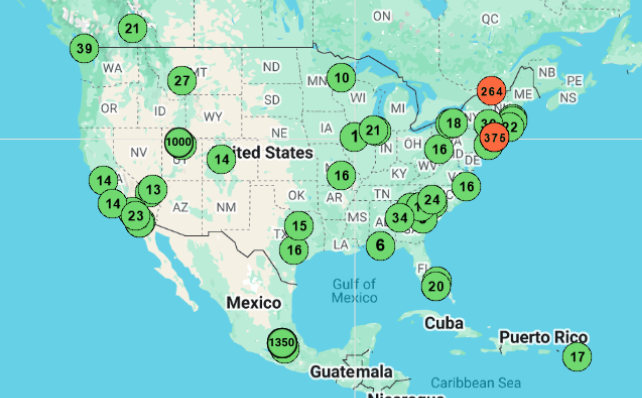
How fake radiation readings in New York and New Jersey, coupled with a mysterious drone swarm, fueled a nuclear scare and became a harbinger for things to come
The ongoing mystery around a New Jersey drone swarm ignited a number of theories last month about who owned the drones and what they were doing in the sky – theories that ranged from the benign to the malign. One dark theory gained more traction than others, however, due to media outlets publishing unfounded stories and interviews about it, and influencers like reality star Bethenny Frankel and podcaster Joe Rogan spreading misinformation about it to their millions of followers.
The theory posited that the drones were U.S. government aircraft that were hunting a nuclear weapon that enemies were set to detonate on the East Coast. "We have to plan for the worst," a China expert told Forbes in an interview about the drones.
According to those trafficking in the national security scare, the government was claiming ignorance about what the drones were doing in order to avoid public panic over the looming nuclear threat. [An alternate theory about the drones suggested they were tracking a radioactive medical device that had gone missing from a December 2 FedEx shipment, but authorities quickly dismissed this.]
The nuclear weapon claim might have received little play if not for one thing – an online radiation monitoring map that seemed to bolster it. The Real-Time Radiation World Map, maintained by GQ Electronics, showed sudden and alarming radiation spikes in parts of New York and New Jersey – two states where the drones were spotted. This seemed to support the theory that the drones might be hunting rogue nuclear weapons. But, alas, the spikes were fake. Unknown perpetrators had submitted false radiation readings to the map.
GQ is a Seattle company that makes commercial Geiger counters for measuring ambient radiation levels in an environment. The devices measure the number of so-called ionization events detected per minute (which get recorded as cpm, or counts per minute) to determine the density of particles present in the vicinity of the device. GQ allows users to upload readings from their devices to an online map that is accessible to the public. But due to lack of authentication protocols on the GQ web site, anyone can upload data to its radiation map.
I contacted security researcher Ruben Santamarta about the elevated radiation readings when information about them began spreading on social media — Santamarta has done extensive research into the security of radiation monitoring systems and discovered anomalies with radiation readings out of Ukraine following the Russian invasion of that country. After looking over the GQ map site, he found that it didn't require authentication or a Geiger device to upload data to it. All a contributor needed was a user account ID and a Geiger counter device ID, which anyone could obtain by registering an account on the site – whether they owned a Geiger counter or not. The user ID and device ID were also displayed in a URL for readings posted to the map, so anyone could discover another user's existing user ID and device ID and use them to upload data to the site or they could obtain their own IDs through registration, Santamarta noted.
“Anyone could upload radiation readings for an existing account or newly created one,” he says.
Poisoned Data
In December as headlines about the drone sightings spread across social media and news sites, the GQ radiation-tracking map began to show exceptionally high cpm readings. Normal cpm levels typically range from 5 to 60 counts per minute, though levels up to about 150 cpm are still generally considered safe. Various benign factors can elevate cpm levels – including wind, precipitation (rain and snow), temperature, altitude and the size and design of the monitoring device, according to the U.S. Nuclear Regulatory Commission. But some of the GQ readings were off the charts.
At first the readings were only slightly elevated, showing 200 or so cpm, but soon the Bronx borough of New York City was showing 1,048 cpm, and other parts of New York state were showing between 500 and 1,000 cpm. Things quickly got out of hand after that.
Reports of the elevated cpm levels on the map began circulating on social media around December 11, and by December 16, a reading for the city of Utica showed an implausible 178,173 cpm. A reading plotted on the map near Trump Tower in New York showed 90,210 cpm. Clearly faulty Geiger devices were at play – or user shenanigans.
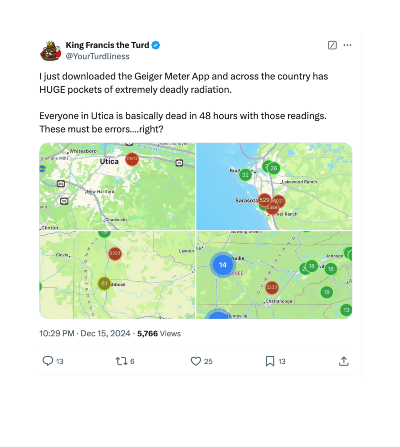
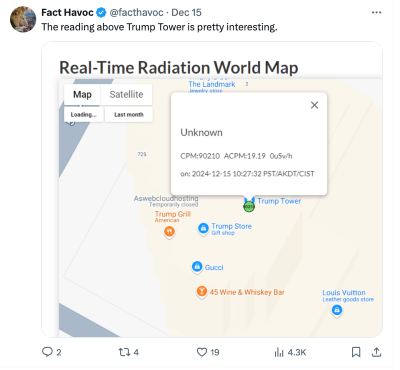
Yet the readings were being taken seriously by many people on social media. If viewers clicked on a reading posted on the map, a popup window provided information about it, such as a username of the person who posted it or a deviceID from which the data was uploaded. It also provided a link to a "History Data" page showing information about all the data uploads the user had made to the map in the past as well as a timestamp for when the data was gathered. But many of the high readings plotted on the GQ map in December either didn't include context for the origin of the data, such as the user who uploaded it, or any historical readings the user previously uploaded, making them suspicious.
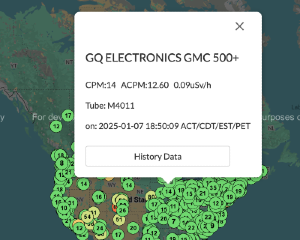
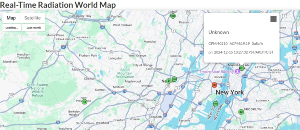
The fake data apparently came from random users who uploaded it for unknown reasons (as a gag? to trigger panic? to demonstrate the foolishness of allowing anyone to post public radiation readings without verification?). The company apparently removed the fake data and temporarily disabled the upload feature after news of the spikes began to spread on social media and members of a GQ Electronics users forum pointed out the suspicious spikes. The company did not respond to several inquiries I sent, but a post on the GQ users forum from someone using the name "ZLM," who appeared to work for the company, indicated they had disabled the upload feature after becoming aware of its abuse. ZLM did not respond to an inquiry from me.
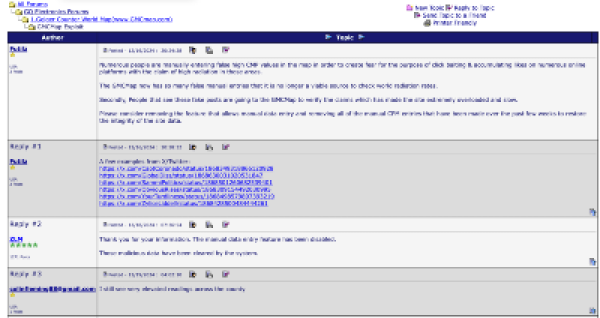
The company at some point restored the upload feature, however, since it's active today and still allows anyone to register an account and upload false data. The company simply added a ticker-tape disclaimer that scrolls at the top of the map page, which encourages visitors to the map to check official government sources for trustworthy data about radiation levels – such as the U.S. Environmental Protection Agency's RadNet site – and not rely on the "citizen's" data posted to its own map:

Santamarta says that preventing manual data uploads from random people by restricting uploads only to legitimate GQ Geiger counters is not a trivial task. It would require adding authentication features and security to the web site and to the devices that communicate with it, which would involve substantial changes to the Geiger counters. This may be beyond the current design and capabilities of the devices, which could explain why the company has left the upload feature in place and simply published a disclaimer to its site. But he says the company could at the very least add authentication just to the web site to prevent random users from using the user and device ID of a legitimate user to upload data, which it apparently hasn't done.
Nuclear Scare Takes Off
With heightened interest and tension over the drone sightings in December, it didn't take long for news of the elevated radiation readings to spread. For social media influencers quick to hit the “post” button without pausing to question the authenticity of the data, the December spikes seemed to be proof that the drones over New York and New Jersey were government devices hunting a radioactive weapon. Among those feeding the scare was Bethenny Frankel, former "Real Housewives of New York" reality star, who posted an alarmist video to her 1.4 million followers on X. She said that some "guy," whose father worked with the "Pentagon and NASA," told her she might want to think about relocating herself and her daughter to a safer location due to the radiation spikes and nuclear threat.
We have to be having this discussion… we can’t be the village idiots. It’s an inauguration year, the world has been at war and radiation is spiked in areas coinciding with a concentration of drones… #scared #news #dronesightings #drones #thingsdohappen pic.twitter.com/iOd5onwHkQ
— Bethenny Frankel (@Bethenny) December 16, 2024
Reality star Bethenny Frankel didn't pause to consider whether the radiation spikes were authentic before posting this video
Frankel wasn't the first or the loudest voice pushing the radiation scare story; others did it before and alongside her. What united them was that while many of them included a caveat that the drones might not be searching for a rogue nuclear weapon, they nearly all accepted as fact that radiation levels in New York and New Jersey were spiking. Few of them or their followers bothered to check official information from the EPA or other similar sources to corroborate that the spikes were real.
🚨🚨🚨Alert: Radiation levels in NYC are spiking!! This is related to the drones!!🔥🔥🔥 pic.twitter.com/I1HhGln3hl
— US Civil Defense News (@defense_civil25) December 15, 2024
Many people on social media assumed the spikes were real and also accepted as fact a theory that the drones were being used to search for a nuclear weapon
Extreme Radiation Levels Spiking Across the U.S.🚨🇺🇸
— Global Dissident (@GlobalDiss) December 16, 2024
And yeah, surprise surprise, New Jersey’s taking the worst hit. Definitely not a coincidence. pic.twitter.com/CPiLrWvV2k
The first mention of the spikes that I could find on social media occurred on December 11, but news about the radiation levels in New York and New Jersey really began to take off two days later after a TikTok video about the drone sightings went viral. John Ferguson, founder of Saxon Unmanned, a Kansas-based company that makes high-end drones for the military and others, posted the video on December 13. In it he opined that the drones might be searching for an errant nuclear weapon left over from the Soviet era and “headed to the U.S.” In the somewhat rambling and convoluted video, he recounts a conversation he recently had with someone who told him the weapon was part of a stockpile of Russian nuclear weapons that Ukraine possessed in the 90s after the collapse of the Soviet Union. The weapons were supposed to be destroyed or sent to the Russian Federation but Ferguson says some of them were unaccounted for, and at least one rogue weapon was now headed to the U.S., according to his unnamed source.
@john.ferguson88 #saxon #drones #uavpilotlife #uap #johnferguson#saxon #drones #johnferguson
♬ original sound - johnferguson/Saxon
The viral TikTok video from John Ferguson that ignited the theory that the drones over New York and New Jersey were searching for an errant nuclear weapon
"Nobody knows where it’s at now. It left Europe, now it’s gone," Ferguson said in the video. He suggested that the night-flying drones over New York and New Jersey might be searching for this weapon, or for something else like a gas leak. "My belief is they’re trying to smell something on the ground, gas, leaks, radioactive material, whatever." The video got 70,000 views around the time it posted and more than 7,000 comments (it's currently at 1.7 million views). It quickly got shared on social media by a number of conservative influencers, including Mila Joy. Her post of the TikTok video got more than 9,000 shares and an estimated 8.7 million views.

The next day, podcaster Joe Rogan shared Ferguson's video on X, where it gained 23 million views, if X analytics are to be trusted. Rogan later asked a former U.S. Navy lieutenant on his podcast about the claim, and his guest nixed the theory saying he had friends in active duty who serve on teams that would be tasked with tracking a rogue nuclear weapon and they told him the theory wasn't true, but the theory continued to spread.
Ferguson never mentioned the radiation spikes in New York and New Jersey in his video, but as his video began spreading on social media, other people began connecting his theory to the radiation spikes.
Kyle Becker, a former Fox News reporter, posted a nearly 1,000-word message on X to his 600,000 followers on December 15 mentioning the spikes, as did author Naomi Wolf to her half a million followers. The ZeroHedge conspiracy site also published a blog post about it and posted a message on X to their piece.
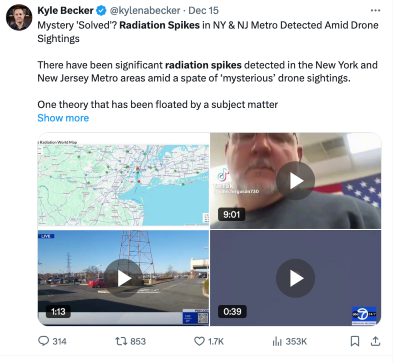
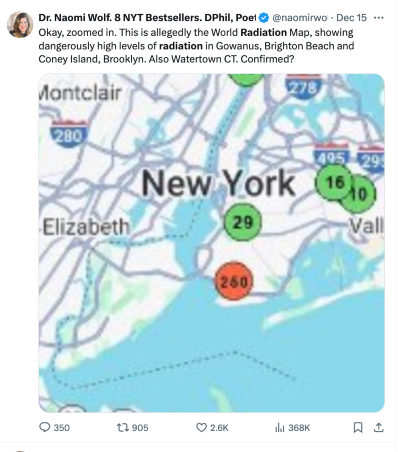
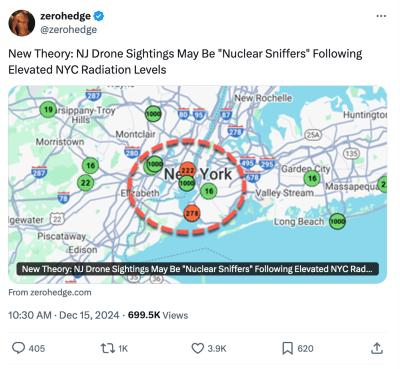
Gordon Chang, attorney and author of several books on China, cited the radiation spikes as fact during interviews he gave to Forbes and Fox News on December 16. The Forbes interview got more than 1 million views online. In it, Chang repeated Ferguson's theory about the drones and cited the fake radiation spikes in New York as evidence that the drones might be searching for "an implanted nuclear weapon" hidden there by Russia or China.
"This is not something which is just wild speculation," he said. "There have been reports of spikes and radiation in the New York metropolitan area. Two of them, one on each side of the Hudson. That leads to the conclusion that maybe they're looking for an implanted nuclear weapon." He went on to speculate about the panic that would ensue if a nuclear device were detonated in the U.S. and said Americans should "plan for the worst."
Several British tabloid publications, including the Mirror and the Daily Mail, picked up the story from there. Around this time, though, radiation spikes were also showing up on the GQ map in regions outside of New York and New Jersey and even outside the U.S. It's unclear if the fake spikes were planted by the same person or by multiple people who discovered they could manipulate the map.
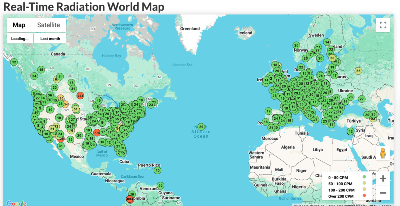
A number of people on social media did question the authenticity of the spikes, pointing out that the GQ map allowed users to upload their own radiation readings and that they might therefore be unreliable. Others searched for more official sources of radiation data that corroborated the spikes but couldn't find any.
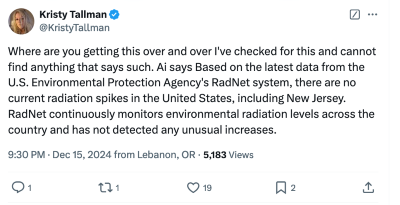
Most people, however, seemed to accept the radiation numbers as fact, and some even saw nefarious motives behind the government's lack of disclosure and discussion about the spikes.
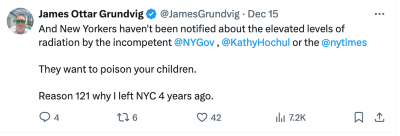
It wasn't until December 18 that the user known as ZLM posted a message to the GQ users forum indicating the company had removed the fake data and disabled the ability to upload data to the map. After this, the spread of the discussion on social media about the spikes began to diminish as people noticed the numbers were gone.
Conclusion
Nothing about this swift spread of fake information is new. We’ve all seen rumors and misinformation take off on social media swiftly. In this case it was easy to dispel the data given that the radiation readings in some cases were so wildly above normal and that no official government sources were reporting spikes in their data. And yet few did question it. What would happen if the data manipulation had been more sophisticated and was done to official radiation readings posted to a government site rather than to a site for amateurs?
The incident caught my attention because of a story I reported for Wired in 2023 about a suspicious pattern of radiation spikes that had occurred in Ukraine at the start of the Russian invasion in 2022. On the day of the invasion, shortly after Russian troops seized control of the Chernobyl nuclear plant in northern Ukraine, an official site for reporting radiation levels in the forest outside the plant began showing alarming spikes in radiation detected in the region. In that case as well, news about the spikes spread on social media, but it was spread by nuclear experts and even by the Ukrainian government – not by amateurs – who did so because they trusted the integrity of the official site where the data got posted. At the time, no one bothered to question the authenticity of the data or the Ukrainian government's explanation that the spikes were likely due to Russian military vehicles stirring up radioactive dirt in the forest around the plant. It was only months later when Santamarta got a tip to examine the data closely that he found suspicious patterns to the spikes that suggested someone had manipulated the underlying data.
Santamarta has done extensive work to examine the security of devices and systems used around the world for monitoring and reporting official radiation levels and has found problems that would allow someone to manipulate radiation data to conduct a more sophisticated nuclear scare campaign than the one that occurred last month. Such campaigns need public gullibility to succeed as well as a willingness among influencers to share information without verification – two factors that were present in the spread of information last month.
Santamarta says it's critical to implement trusted radiation monitoring systems that ensure the integrity, authenticity, and traceability of the readings. "Otherwise malicious actors may systematically exploit fear of radiation to amplify or position their narratives, parasitizing legitimate events to turn them into causes for societal anxiety or serve other specific objectives." But he notes that educational initiatives that emphasize critical thinking are important as well to help counter these scenarios when they arise and foster better understanding of radioactivity and how radiation monitoring works so the public and media are easily duped. He's written a guide to help evaluate information about radiation spikes when they occur.
It's not clear if the radiation scare tied to the drone sightings in December was part of an intentional campaign to sow fear and panic – it's difficult to locate the first accounts across social media platforms that began spreading the elevated numbers from the GQ map and it's also difficult to know, without cooperation from GQ Electronics, who posted the first fake readings to its map or their motives. But the rapid spread of the information is instructional for anyone who might want to seed a more sophisticated nuclear scare campaign going forward – especially one that might involve manipulation of official radiation monitoring devices or web sites like the ones in Ukraine. Seeing how quickly people accepted and believed radiation spikes that were crudely manufactured, it's easy to imagine the panic that would ensue if a more believable campaign were manufactured.
Related Coverage:
The Mystery of Chernobyl's Post-Invasion Radiation Spikes
Radiation Spikes at Chernobyl: A Mystery Few Seem Interested in Solving
Share and Subscribe
Thank you for reading. If you found this article useful or interesting, feel free to share it with others.
Zero Day is a reader-supported publication. You can support my work by becoming a paid subscriber and receiving content that is only available to paid subscribers in addition to all free content; or you can subscribe for free.